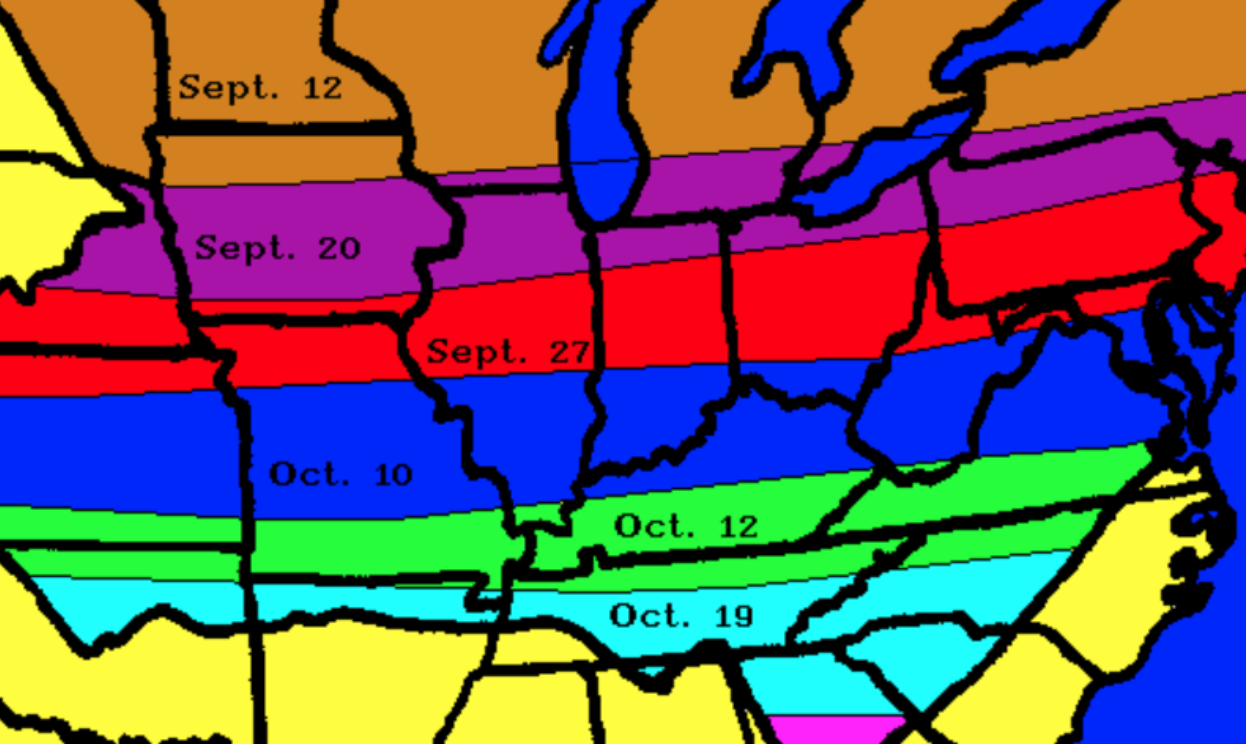Update from the Field: Time for Me to Fly
Posted on September 15, 2020

As soybean harvest begins in areas across the Corn Belt and wheat prices start to rebound, some producers are looking at putting a third crop back into their rotation. Wheat can be a very profitable crop if insects, weeds and diseases are properly managed.
The Hessian fly is the first pest to consider when determining a planting date for wheat. These unwanted immigrants came to North America in the straw bedding of the Hessian troops during the American Revolution. Planning to plant once the Hessian fly has become inactive is the best defense against this pest, Figure 1. This date is also known as the fly-fee date. In the Southern/Central Corn Belt, the date when it is safe to plant wheat is usually after the middle of September. In the northern Corn Belt, the fly-free date is not as critical but a good guideline for when to plant wheat.

Figure 1: This chart from the University of Wisconsin shows the different fly-free dates as you travel throughout the Corn Belt. http://corn.agronomy.wisc.edu/Crops/Wheat/images/L006/planting.gif
Barley yellow dwarf virus has become more of a problem in the past few years. This virus can cause up to 20% yield reduction in a winter wheat crop. The symptoms can resemble nutrient deficiencies or damage from low temperatures. The cherry wheat aphid can transmit the virus that causes the barley yellow dwarf virus. Systemic insecticides can be the most effective in stopping fall aphids. Contact insecticides have a quick knockdown of aphids, but it can be difficult to choose the timing of application.
Winter annual weeds can be very damaging to the emerging wheat crop. Planting the correct population will help in controlling weeds. Aim for a target population of 1.7 million seeds per acre. A thicker seeded crop will help prevent weeds from establishing. A warm, wet fall can increase the chickweed and purple dead nettle populations which can smother young wheat plants. It is essential to scout fields and make sure these winter annuals don’t get out of control. Spraying the wheat with 15oz/ac of Huskie® herbicide can eliminate winter annual weeds and provide residual weed control throughout the spring. This method will allow for the application of Harmony® Extra herbicide if an additional control is needed in the spring.
A good fertility program is essential for a healthy wheat crop. Just like during corn planting, the use of a high quality, low salt starter will ensure a quicker emergence. The Andersons PureGrade® starter portfolio encourages growers to apply 10-12 gal/ac for a healthier stand. A wheat crop requires 120 total units of nitrogen during the growing season. If the wheat crop follows soybeans, you can use 20 units of nitrogen from the soybean credit toward the total. The remaining 100 units need to be divided up between fall and spring. My typical fertility recommendation is 100lb/ac of AMS, 100lb/ac of MAP, 100lb/ac of potash, and 2lb/ac actual of zinc. The balance of the nitrogen should be applied during top dress in the spring with UltraMate® Zn. Adding 1gal/ac of UltraMate Zn to a UAN solution will complex the nitrogen while providing the additional benefits of zinc. This recommendation ensures the plant receives enough nitrogen in the fall to promote tillering of the wheat plant, while providing adequate levels of nitrogen to support crop growth in the spring.
In conclusion, it is essential to apply a good fertility package that will promote fall growth and tillering over winter. Scouting during and after wheat emergence is imperative to diagnose pest, weed and disease pressure. Planting after the fly-free date will minimize the impact of the Hessian fly and barley yellow dwarf virus.
FOR MORE INFORMATION:
Please complete the form, and we’ll get you in touch with your Territory Manager from The Andersons.

Dave Dyson is a regional agronomist for The Andersons’ Farm Centers which are located throughout Ohio, Michigan, and Indiana. He is an Indiana native and grew up on a dairy farm in Miami County. A graduate of Purdue University with a degree in Crop & Soil Science, Dave has a deep knowledge of various agronomic topics and is committed to helping growers improve their crops. If you have any questions, Dave can be reached at david_dyson@andersonsinc.com.
© 2020 The Andersons, Inc. All Rights Reserved. PureGrade and UltraMate are registered trademarks of The Andersons, Inc. HUSKIE is a registered trademark of Bayer. Harmony is a registered trademark of FMC Corporation.


